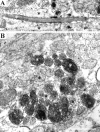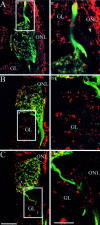Specificity of glomerular targeting by olfactory sensory axons
- PMID: 11923411
- PMCID: PMC6758332
- DOI: 10.1523/JNEUROSCI.22-07-02469.2002
Specificity of glomerular targeting by olfactory sensory axons
Abstract
Axons from olfactory sensory neurons (OSNs) expressing a specific odorant receptor (OR) project to specific subsets of glomeruli in the olfactory bulb (for review, see Mombaerts, 1999, 2001). The aim of this study was to examine the trajectories that subsets of axons from OSNs expressing the same OR follow within the olfactory nerve and olfactory nerve layer (ONL) of adult mice. Using confocal microscopy, we generated serial reconstructions of axons from M72-IRES-tauGFP-expressing OSNs as they coursed within the ONL and into glomeruli. GFP-expressing axons were loosely aggregated in the outer ONL; however, as they entered the inner ONL, the majority fasciculated with other GFP-expressing axons before entering the glomerular neuropil. Although the vast majority of axons entered the glomerulus from the directly apposed ONL, some followed tortuous courses through and/or around adjacent glomeruli before terminating in the target glomerulus. Similar observations were made on subpopulations of axons in M71-IRES-tauGFP and P2-IRES-tauGFP mice. Ultrastructural analyses of labeled M72 glomeruli showed no evidence of axodendritic synapses other than those with GFP-labeled axon terminals. These data are consistent with the notion that OSN axons are highly precise in targeting glomeruli and that glomeruli, in turn, are highly homogeneous with regard to the OR expressed by the innervating OSNs. Because some single axons could follow idiosyncratic trajectories to the target glomerulus, it appears that stable homotypic fasciculation is not a prerequisite for correct targeting.
Figures








References
-
- Berod A, Hartman BK, Pujol JF. Importance of fixation in immunohistochemistry: use of formaldehyde solutions at variable pH for the localization of tyrosine hydroxylase. J Histochem Cytochem. 1981;29:844–850. - PubMed
-
- Conzelmann S, Levai O, Bode B, Eisel U, Raming K, Breer H, Strotmann J. A novel brain receptor is expressed in a distinct population of olfactory sensory neurons. Eur J Neurosci. 2000;12:3926–3934. - PubMed
-
- Firestein S. How the olfactory system makes sense of scents. Nature. 2001;413:211–218. - PubMed
-
- Gad JM, Keeling SL, Wilks AF, Tan SS, Cooper HM. The expression patterns of guidance receptors, DCC and Neogenin, are spatially and temporally distinct throughout mouse embryogenesis. Dev Biol. 1997;192:258–273. - PubMed
-
- Gogos JA, Osbourne J, Nemes A, Mendelsohn M, Axel R. Genetic ablation and restoration of the olfactory topographic map. Cell. 2000;103:609–620. - PubMed
Publication types
MeSH terms
Substances
Grants and funding
LinkOut - more resources
Full Text Sources
